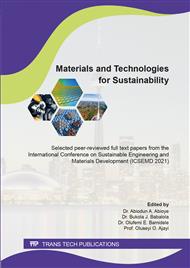p.170
p.185
p.199
p.207
p.228
p.241
p.250
p.258
p.269
The Influence of Nanoparticle Additive on the Thermophysical Properties of Bionanolubricant Using Castor Oil
Abstract:
Lubricants are commonly used in machining and energy system to reduce friction and wear within moving parts and aid in the transfer of heat. The use of lubricants enhances the overall performance and operation life of systems. Synthetic lubricants commonly used are non-biodegradable and are harmful to aquatic and land habitats. To overcome these challenges, biolubricants from vegetable and animal sources were considered as an alternative to synthetic and mineral lubricants. In this study, the esterification and transesterification processes were used to produce biolubricant from castor oil. Methanol and sulphuric acid (H2SO4) were used as alcohol and catalyst respectively for the acid catalysed esterification while ethylene glycol and sodium hydroxide (NaOH) were used for the transesterification process. The average biodiesel yield was 99.87%. The two-step method was deployed in the preparation of the castor nanobiolubricant. The nanobiolubricants were prepared using aluminium oxide (Al2O3) nanoparticles of 20 – 30 nm nominal diameter. The volume concentrations of 0.1%, 0.2%, and 0.4% were used in the preparation of the nanobiolubricants. The results showed that the addition of Al2O3 nanoparticles into the castor oil biodiesel altered the thermophysical properties (density, dynamic viscosity, pH, acidity, free fatty acid (FFA), flash point, and cold properties) of the biolubricants. The addition of Al2O3 nanoparticles reduced the acidity, flash point, and pH value of biolubricant while the cold flow property was improved. The dynamic viscosity decreased with an increase in temperature and increased as the nanoparticle concentration increased. The results were compared with the thermophysical properties of mineral oil, and from these analyses, Al2O3 nanobiolubricant can be successfully deployed as an alternative to synthetic and mineral lubricants in machining and energy systems. Fourier transform infrared (FTIR) and UV-Vis analyses were conducted on the castor oil, its biolubricant, and nanobiolubricants.
Info:
Periodical:
Pages:
228-238
Citation:
Online since:
April 2022
Price:
Сopyright:
© 2022 Trans Tech Publications Ltd. All Rights Reserved
Share:
Citation:


